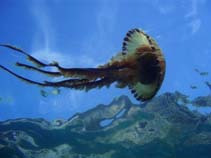Chrysaora hysoscella (Linnaeus,1766)
Compass jellyfish| Native range | All suitable habitat | Point map | Year 2050 |

|
| This map was computer-generated and has not yet been reviewed. |
| Chrysaora hysoscella AquaMaps Data sources: GBIF OBIS |
Classification / Names Common names | Synonyms | CoL | ITIS | WoRMS
Scyphozoa | Semaeostomeae | Pelagiidae
Environment: milieu / climate zone / depth range / distribution range Ecology
Pelagic; depth range 0 - 500 m (Ref. 3292), usually 0 - 150 m (Ref. 3292). Tropical; 13°C - 21°C (Ref. 3292); 60°N - 27°S, 60°W - 15°E (Ref. 3292)
Distribution Countries | FAO areas | Ecosystems | Occurrences | Introductions
Atlantic Ocean and the Mediterranean.
Length at first maturity / Size / Weight / Age
Maturity: Lm ? range ? - ? cm Max length : 20.0 cm WD male/unsexed; (Ref. 2992)
Short description Morphology
Up to 20 cm wide; marginal lappets all alike, semicircular, thin; stomachpouches all of equal width, septa straight; in each octant 3 tentacles, all alike; exumbrella with 16 broad radial brown bands bordered by darker, narrow V-shaped lines; marginal lappets brown.
Usually found inshore, more dominant at dusk (Figure 3, Ref. 3292).
Life cycle and mating behavior Maturity | Reproduction | Spawning | Eggs | Fecundity | Larvae
Members of the class Scyphozoa are gonochoric. Life cycle: Egg is laid by the adult medusa which later develops into a free-living planula, then to a scyphistoma to a strobila, and lastly to a free-living young medusa.
Main reference
References | Coordinator | Collaborators
Kramp, P.L. 1961. (Ref. 2992)
IUCN Red List Status (Ref. 130435: Version 2024-1)
CITES status (Ref. 108899)
Not Evaluated
CMS (Ref. 116361)
Not Evaluated
Threat to humans
Human uses
| FishSource |
Tools
More information
Trophic Ecology
Ecology
Population dynamics
Life cycle
Distribution
Human Related
Aquaculture profile
Stamps, Coins Misc.
Stamps, Coins Misc.
Outreach
References
Internet sources
BHL | BOLD Systems | CISTI | DiscoverLife | FAO(Publication : search) | Fishipedia | GenBank (genome, nucleotide) | GloBI | Gomexsi | Google Books | Google Scholar | Google | PubMed | Tree of Life | Wikipedia (Go, Search) | Zoological Record
Estimates based on models
Preferred temperature
(Ref. 115969): 8.1 - 15.5, mean 10.8 (based on 1074 cells).
Resilience
(Ref. 69278):
High, minimum population doubling time less than 15 months (K=1.1-4.3).
Price category
(Ref. 80766):
Unknown.



